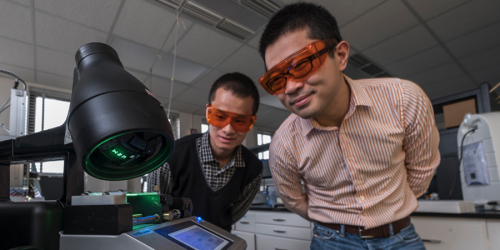A team of engineering researchers at Michigan State University have developed the first stretchable integrated circuit that is entirely made using an inkjet printer. This innovation could lead to the possibility of inexpensive mass production of smart fabrics.
This research was led by Chuan Wang, an assistant professor of electrical and computer engineering at Michigan State University.

Source: MSU
This innovation could lead to countless potential applications such as a super-thin smart tablet that could easily be stretched from sizes small to extra large, or a rubber type wrist monitor that can measure a person’s heartbeat, or possibly a wallpaper that can turn an entire wall into an electronic display.
These are only some of the potential applications of the stretchable smart fabric that is being developed in Wang’s laboratory. Also, since this material can be produced on a standard printer, it has a great potential cost advantage over current technologies which are usually expensive to manufacture.

Source: Tumblr
According to Wang, “We can conceivably make the costs of producing flexible electronics comparable to the costs of printing newspapers. Our work could soon lead to printed displays that can easily be stretched to larger sizes, as well as wearable electronics and soft robotics applications.”
This new smart fabric is made up of different materials that are fabricated from organic materials and nanomaterials. These compounds will be dissolved in a certain solution to produce various electronic inks, which will be run through the printer to make the devices.
By using these newly developed ink, Wang and his team were able to successfully create the elastic material, the integrated circuit, as well as the organic light-emitting diode, or OLED. The next step is they would combine the circuit and the OLED into a single pixel, wherein may take around one or two years according to Wang. There are millions of pixels underneath the screen of smart tablets or large smart displays.
Once the researchers have successfully combined the circuit and OLED into a working pixel, the smart fabric will be then ready to be potentially commercialized.
According to Wang, the stretchable electronic fabric is capable of being folded and put in one’s pocket without it breaking. This is a great advantage over “flexible” electronics that are currently in the market that cannot be folded.
“We have created a new technology that is not yet available. And we have taken it one big step beyond the flexible screens that are about to become commercially available.” Wang said.
Article Source:















